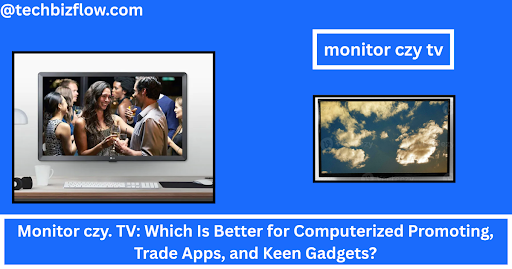In an age where screens rule our professional and individual lives, choosing the right show for your needs, whether it’s advanced showcasing, trade applications, or shrewd gadget integrations, is more critical than ever. That choice frequently bubbles down to one significant address: monitor czy. TV, which is the better choice? This comprehensive review will offer assistance to help you understand the qualities and limitations of each and direct you toward an educated choice.
Table of Contents
- The Essentials: What You Get with a Monitor
- What You Get with a TV
- Digital Showcasing: Which Show Underpins Imagination and Productivity?
- Business Applications: From Spreadsheets to Presentations
- Smart Contraptions: The Part of the Show in Your Associated Life
- Comparing Picture Quality, Speed, and Connectivity
- Ergonomics, Eye Consolation, and Health
- Budget Contemplations and Long-Term Value
- Practical Scenarios: Real‑World Utilization Cases
- Final Decision: How to Decide
1. The Essentials: What You Get with a Monitor
A screen, ordinarily outlined for computers, centers on sharpness, responsiveness, and clarity. If your workflow revolves around working at a desk, typing, planning,and coding, monitors are your friend.
High Determination and Precision
Monitors regularly offer fresh content rendering and precise colors, making them perfect for assignments like realistic planning, altering, and exact information examination. A 4K screen shows fine, subtle elements that TVs frequently gloss over.
Input Slack and Revive Rate
For experts working in fast-paced situations particularly computerized marketers utilizing program interfacing moo input slack and tall revive rates (60, 120, indeed 240 Hz) translate to nearly momentary input. Small delays make a huge contrast in efficiency.
Desk Introduction and Ergonomics
Monitors are built with stature alteration, tilt, swivel, and VESA mount back. This permits fine-tuned pose control, good for long hours at a work area. It’s less demanding to adjust a monitor’s sightline than a couch-lounged TV.
Specialized Features
Many screens offer highlights particular to efficiency and inventive work: factory-calibrated color profiles (sRGB, Adobe RGB), blue-light sifting, devoted gaming highlights, and variable revive rate tech—all contributing to superior comes about and comfort.
2. What You Get with a TV
Televisions come with huge screens aiming for seeing from separations, regularly in loose seating arrangements. They sparkle where substance utilization, amusement, and family utilization are the priority.
Large Screen Sizes at Lower Cost
You can get a 55- or 65-inch 4K TV for less per inch than an essentially measured screen. For showcasing introductions or collaborative sessions, a family-room fashion TV can feel immersive and inclusive.
Built-In Savvy Features
Modern savvy TVs coordinate app environments like Netflix, YouTube, or indeed proficient stages like Zoom. A few incorporate built-in browsers or app stores—handy when interfacing with contraptions like Raspberry Pi, Amazon Fire TV Stick, or Chromebox yourself.
Simplicity and Convenience
Plug-and-play effortlessness beats a multi-cable screen setup any day for casual clients. TVs frequently incorporate numerous HDMI ports, sound outputs, and all-inclusive remotes—no complex settings needed.
Eye-Catching Look
Hallmarks like tall differentiation OLED boards, dynamic HDR, and wide seeing angles can make visual promotional materials pop in ways a smaller screen might not, particularly in group settings.
3. Digital Showcasing: Which Show Underpins Imagination and Productivity?
Your screen impacts your temperament and yield. Here’s how each show sort adjusts with a computerized promotion workflow.
Photo and Video Editing
- Monitors: Exact color repro, veritable 1:1 pixel mapping, and sharp center matter when altering advertisements, websites, or social media visuals. A calibrated screen guarantees that what you see is what your group of onlookers will see.
- TVs: Dynamic, oversaturated colors may seem lovely, but don’t convey precision. If you alter visuals specifically on a TV, anticipate jumbles when plans go live.
Multitasking and Side‑by‑Side Work
- Monitors permit split-screen formats, different windows open, and liquid drag-and-drop essential for multitasking and comparing promoting assets.
- TVs, unless associated with a PC, don’t support covering windows or virtual desktops. Indeed, with a PC, client interface sizes regularly feel awkward.
Presentations & Showcases
- TVs appear in gathering settings: everybody can assemble around for technique sessions, advance offers, or pitches.
- Monitors, whereas incredibly up near, need the social show control of a huge screen.
Remote Collaboration
A screen with a webcam and USB ports cultivates consistent Zoom, Groups, or Meet sessions. TVs some of the time make amazing shared seeing devices but do not supplant intuitively desktop workstations.
4. Business Applications: From Spreadsheets to Presentations
Let’s look at spreadsheets, introductions, and dashboards the bread-and-butter of day-to-day business.
Spreadsheets and Databases
- On a screen, little network lines stay sharp and discernible. You can see more columns and columns at once.
- On a TV, textual styles can obscure and drain, straining eyes. Indeed, high resolutions don’t ensure freshness in close-range desktop use.
Presentations
- With a TV, plug-and-play by means of HDMI implies sharing introductions without a hitch. Remote-control playback, coordinates speakers—no additional setup.
- A screen requires interfacing peripherals (mouse, console, perhaps speakers), which some of the time leads to network hitches in assembly rooms.
Data Dashboards
- Monitors regularly run double setups, letting you screen analytics, deals, and reports simultaneously.
- Big-screen TVs make dashboards obvious to teams, but interaction may require multitouch overlays or remote mice.
5. Smart Contraptions: The Part of the Show in Your Associated Life
Display choice things in a world filled with keen ice chests, domestic collaborators, Raspberry Pis, remote cast dongles, and IoT dashboards.
Treating Your Show as a Shrewd Hub
- Use a screen with an associated mini-PC or adhere like Compute Adhere or Chromebox, and it becomes your individual control center, cleanly tucked on a desk.
- Turn a TV into a living-room command support with Amazon Fire TV Stick, Chromecast, or Apple TV. Control domestic robotization apps on-screen, including Ring cameras, indoor regulators, and more.
Interactivity
- Monitors sometimes incorporate touchscreens or USB-C docks, empowering more coordinated device management.
- On TVs, interactivity comes from outside remotes or voice commands (Alexa, Google Right Hand), exchanging manual control for comfort in open spaces.
Presentation Mode vs. Office Mode
- A TV pairs as a collaborative show amid gatherings and as excitement in off-hours.
- A screen tends to remain in proficient mode, but can still stream Netflix after work if needed.
6. Comparing Picture Quality, Speed, and Connectivity
Resolution and Color Fidelity
- Monitors emphasize pixel exactness: 4K UHD (3840×2160) or indeed 5K shows, Adobe RGB scope, and industry calibration.
- TVs might offer 4K HDR but regularly compress or upscale signals. Illustrations may show up marginally gentler when seen up close.
Input Slack and Refresh
- Monitors: Responsiveness up to 240Hz; moo lag for quick workflows, realistic plan, and light gaming.
- TVs: Regularly 60Hz, with higher lag fine for observing recordings, not perfect for intuitive tasks. Gaming-focused TVs exist but do not necessarily coordinate screen agility.
Connectivity
Monitors: DisplayPort, HDMI, USB-C/Thunderbolt, USB-Centers over and behind.
TVs: Parts of HDMI, optical sound, ethernet, and some of the time USB-A; built-in speakers greater than screens, but sound clarity varies.
7. Ergonomics, Eye Consolation, and Health
Viewing Remove and Size
A 32-inch screen is comfortable at approximately two feet. A 55-inch TV requires a separate of six to eight feet to avoid eye strain.
Blue-Light and Flicker-Free Options
Many screens presently incorporate progressed eye-comfort features like hardware-level blue-light channels or flicker-free backlighting. TVs may incorporate “eye-care” modes, but regularly as were software-adjusted filters.
Posture and Engagement
Sitting near a screen energizes an upright pose and center. Observing substance on a TV tends to lead to slouching for recreation, but not for everyday work.
8. Budget Contemplations and Long‑Term Value
Monitors
These extend widely basic FHD models at ~$150, up to pro-level 32-inch 4K for $800–$1,200. Specialized screens (HDR1000, ProArt arrangement) go past $2,000.
TVs
A mid-range 55–65″ 4K HDR TV sits between $500–$900. Large-screen gaming TVs or OLED models drift higher ($1,200+), but still offer uncommon show quality for the cost.
Total Fetched of Ownership
- Monitors ordinarily back 24/7 utilization longer without burn-in chance, as they’re built for desktop tasks.
- TVs, particularly OLEDs, may endure progressive burn-in or image persistence with inactive UI layouts.
9. Practical Scenarios: Real‑World Utilization Cases
Here are a few practical cases to outline which work best:
Scenario 1: Solo Imaginative Professional
- Works with Adobe Inventive Suite, web design, composing, and planning.
- Needs exact visuals, windowed multitasking, and content clarity.
Winner: Monitor, possibly a dual-monitor setup.
Scenario 2: Little Organization or Startup
Needs to create mockups for clients, screen dashboards, do back-office errands, and unwind with a movie overnight.
Winner: A combination—desktop screen + shared TV in a communal area.
Scenario 3: Father Specialist in a Compact Apartment
Does inaccessible deals introductions, incidental altering, and after-hours web series.
Winner: A high-res screen for work, but include a little shrewd TV or casting adhere for entertainment.
Scenario 4: Office-based Promoting Team
Uses computerized signage devices, information dashboards, video advertisement looking into, and holds meetings.
Winner: Huge TV for bunch sharing; desktops get monitors.
10. Final Decision: How to Decide
To select between screen vs. TV:
Define your utilize case:
• Accuracy work, windowed multitasking → go monitor.
• Shared seeing, introductions, video playback → consider a TV.
Evaluate workspace and distance:
• Desk-based, at arm’s length → monitor.
• Workspace obliges 6–8 feet → TV.
Budget and longevity:
• Pro-caliber screen = higher forthright fetched, built to last.
• TV = more screen for less, but utilize carefully to dodge burn-in.
Hybrid approach:
• Numerous groups advantage from utilizing both. Screens for day‑to‑day, TVs for group interaction, and a smart‑home review.
Final Thoughts
Choosing between a monitor czy. TV eventually depends on what you do, where you work, and how you work. For centered, day by day substance creation and proficient applications, a high-quality screen is difficult to beat. On the other hand, if your workflow frequently brings you out of the chair, welcomes collaboration, or leans intensely on video and associated technologies, a keen TV can shine.
In numerous real-world setups, the most compelling arrangement is a hybrid—use a sharp, dexterous screen for work area work and keep a TV prepared for all-staff audits, inaccessible gatherings, or end-of-the-week downtime. Your show choice doesn’t have to be all or nothing.
FAQs
Can a TV be utilized as a computer screen for work?
Yes, but it may need clarity and responsiveness compared to a devoted monitor.
Is a screen superior to a TV for computerized advertising tasks?
Screens offer predominant color exactness and multitasking capabilities, perfect for promoting work.
Which is more reasonable for trade introductions, a screen or a TV?
A TV is regularly better for group introductions due to its larger screen size.
Are keen TVs consistent with trade apps and shrewd gadgets?
Numerous savvy TVs back apps and gadget integration, but with constrained interactivity.


